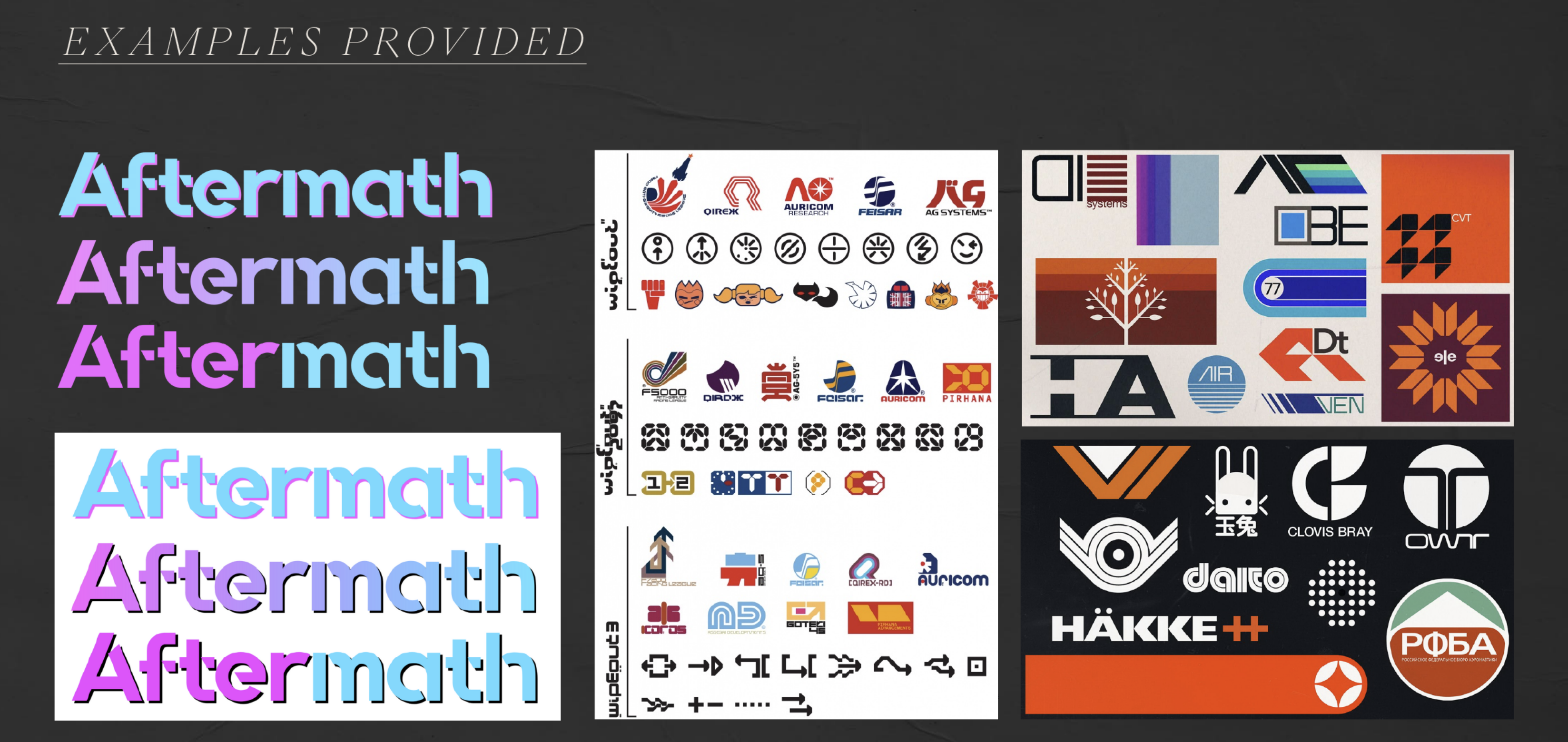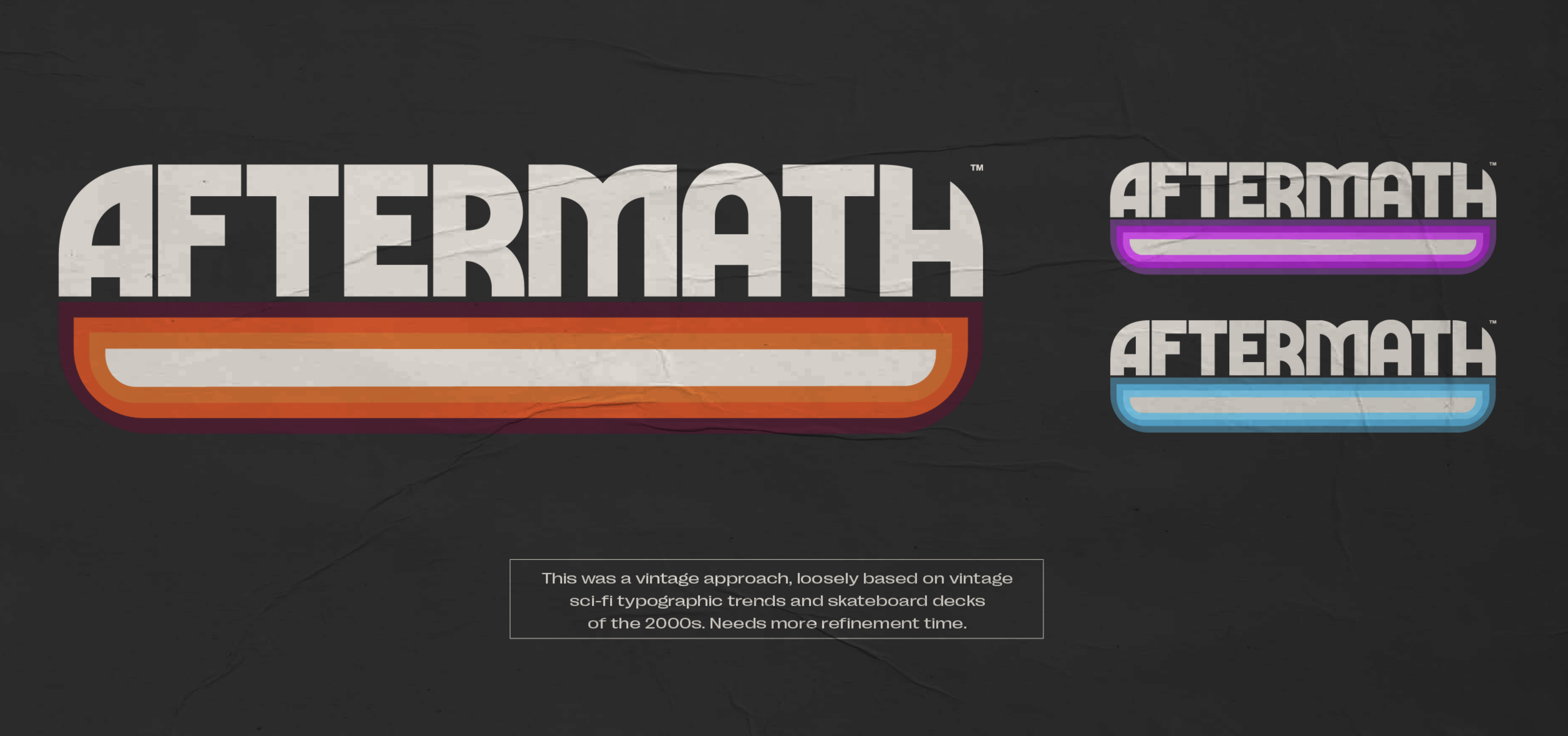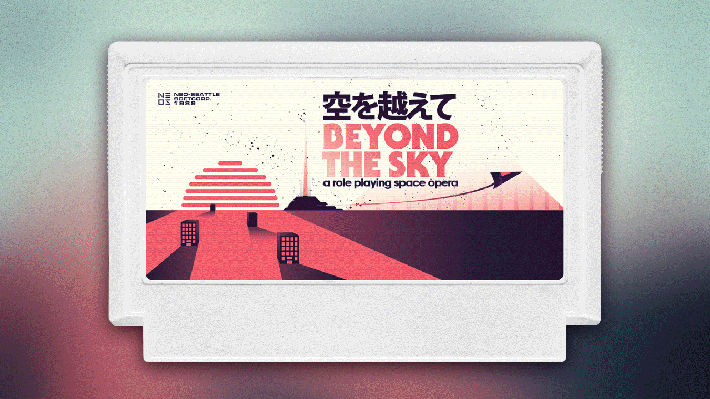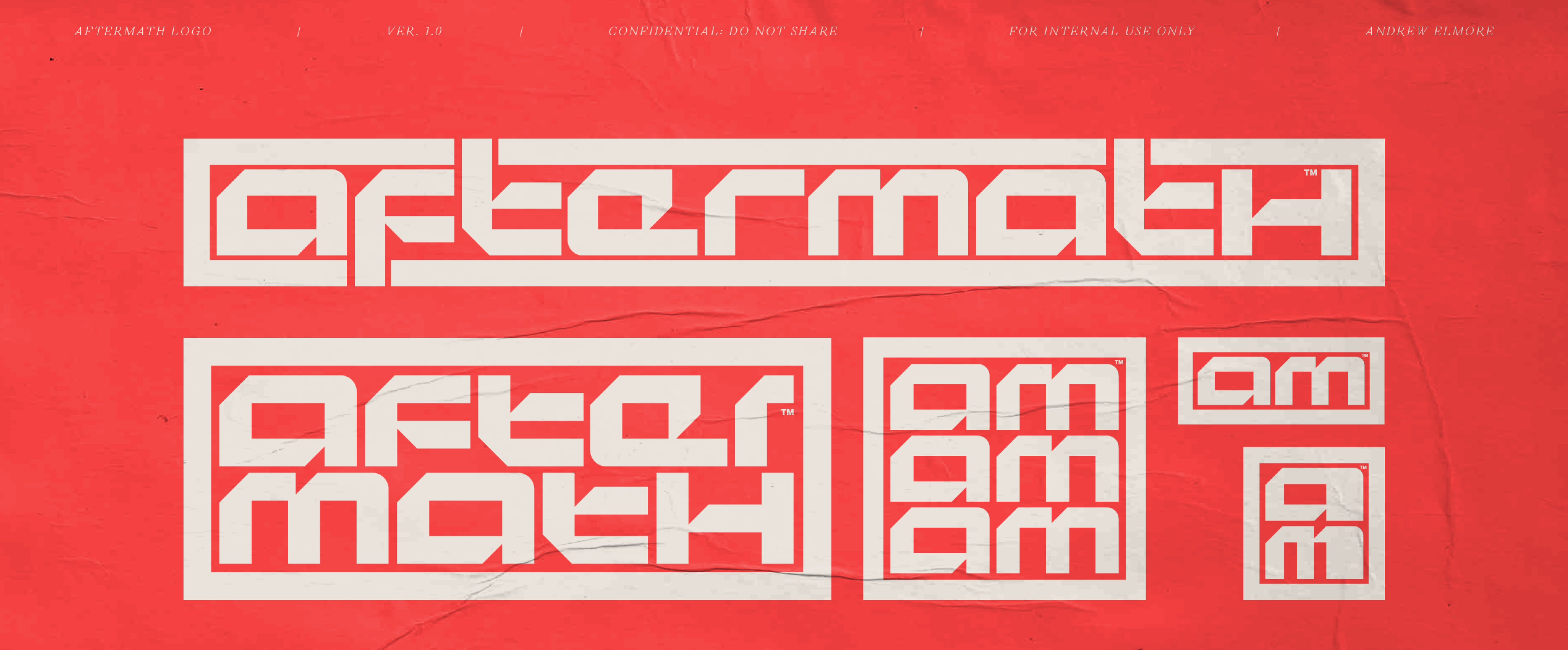OK, Inside Baseball week. Let's see how Inside Baseball we can get.
When we decided we were going to do this whole Aftermath thing, we had a few very big decisions to make. The first and perhaps most important, if only for domain-purchasing and social media account-related reasons, was our name. The second, after we eventually settled on that, was our branding.
When people say starting your own business is exciting, they don't mean all the tax stuff and administrative paperwork and payroll. That's boring. The good shit is getting a chance to build a workplace with an identity, a business that means something, and for us that started with the site's name and logo.
The story behind the name is quick and not very interesting. We had a little Discord setup to organise the site's creation, had a channel in there just for name ideas, and kept dumping suggestions in there for months until one of them stuck. Aftermath was actually one of the first we tried out, and when it transpired after dozens of subsequent attempts that it was the one we hated the least--and also the one we could get a domain name for that didn't cost us thousands--we settled on it.
The story behind our logo, though, is a lot more fun. Well, it was fun for me at least, the guy who immediately took charge on it because I had ideas. I had a very long history of doing image and logo work for Kotaku; I did most of the logos for the site's regular feature badges, got to build my own Cosplay website once (before bumbling owners accidentally deleted it) and in older times had even been allowed to completely make the site over for special events like the Tokyo Game Show. Given the chance to build a whole new website from the ground up, for a publication with a name that wasn't extremely annoying and would even let us pick our own themes and colour scheme, was exciting.
But the logo itself was also going to take the work of a professional, so I reached out to Andrew Elmore, an artist who at the time had been working at Bungie on Destiny. Because Aftermath was going to be both something old and new, and based mostly around tech-adjacent stuff, he seemed a perfect fit; I told him we needed a retro-futuristic vibe, asking in an email for "something you'd see on the wall of Destiny's Cosmodrome. Something you'd see next to a Pan-Am logo in an aspirational Syd Mead commercial booklet from the 70s. Something you'd see in Moon, or in Wipeout". Here's what I sent him for inspiration, including an early mock-up of some colour scheme ideas (the pink survives if you're using our site's dark mode!):

After some initial back-and-forth, Andrew came up with four different approaches, each one with a slightly different vibe. The first was this "raw typographic treatment", which I liked very much, but as he says, also has a "2020's tech website" energy that cut a little too close to The Verge's recent and excellent redesign:

The second was this, which was a little bit retro sci-fi and a whole lot of 2000s skate deck/stoner rock. Again, all things very close to my heart, but also not quite what we were looking for in terms of Aftermath.

The third option was this retro LCD watch-style effort, which was inspired by all kinds of stuff up to and including old Warp Records releases. It definitely nailed that, but again, wasn't what Aftermath was really going to be about:

Which brings us to this fourth and final suggestion. It was Andrew's favourite, and it was instantly ours as well. It was old and new, it looked cool as hell and the modular nature of it, which would allow us to resize stuff for various needs (social media profile pics, banners, the favicon of the browser tab you're currently reading this in, etc.), was also really practical.

Once we'd all signed off on it as our favourite, Andrew got to work iterating on it--he has the patience of a saint, as we kept having to make really minor tweaks to improve the readability of the text--and after a few weeks we arrived on the branding you see all around you on the site today, something that I still look at on an almost daily basis and think, damn, that amazing logo isn't for some classic video game or amazing cult sci-fi movie, it's for our website.
With that self-indulgence out of the way (thank you for your patience!), it's now time to move onto the actual point of a Platform post here on Aftermath: chatting with Andrew and showcasing some of his work!
Luke Plunkett: Hey man! We know you, but for the sake of everyone reading this, tell us about yourself. As much or as little as you want.
Andrew Elmore: Hey! I'm Andrew. I'd leave it there but that's Gita's joke. I'm a visual designer and composer for video games, based out of Seattle, WA.
LP: So, uh, a week before Aftermath launched you were laid off from your job at Bungie. What had you been doing there until that? And what kind of work had you been doing before that?
AE: Oh man. A lot! I started at Bungie shortly after their split from Activision in 2019, joining an internal visual identity/design team that was a part of the newly-formed publishing organisation within the studio. Over my (not quite) five-year tenure I ended up doing all sorts of things, it was a wild ride—usually in a good way! The vast majority of my memories there are very fond. Over the years our team expanded to include more and more designers, artists, producers, etc., allowing us to specialize and focus on specific types of work. In the beginning it was a combination of learning how to support the seasonal cadence of a live game schedule alongside building up to our first big expansion release (Destiny 2: Shadowkeep) as an independent company.

I think the first thing I worked on was the seasonal calendar for Season of Opulence. It was that or the infamous TR3-VR t-shirt, those were both within the same week or two. Everything we did was a team effort: designing logos, key art, websites, marketing materials, social graphics, press kits, the works! We also worked in tandem with our Consumer Products and Video teams for all of our apparel, merch, books and packaging, as well as trailers and motion graphics, etc. We also worked a lot with individual dev teams on things like in-game and in-fiction art, UI materials, emblems and R&D. Several times I've tried to list off every Type Of Thing I made in half a decade on Bungie's Viz Development team, and it's never been 100% conclusive. There's so much weird stuff that goes into shipping a game that no one thinks about, even when you've been in perpetual "shipping" mode since the game launched, since that's more or less what operating a big-ass live service game is like. I had this Ben Esposito tweet printed out at my desk because the infinite specificities contained within were emerging anew with each day.
One good example from my first year: you know all those little key art images for any given game on a digital storefront? Those have to be made, to each individual proprietary size, in every single language your game supports, and on every platform. At some point, we were simul-shipping three SKUs in 12 or 13 languages, across all our normal platforms, while also migrating to Steam and launching on Stadia. Each platform had a completely different set of specs for all the different sizes and formats they'd need for image outputs. Do you know where those usually come from? I sure don't! Publishers, probably! But now we were self-publishing. Activision wasn't there to solve this problem, which meant Andrewvision was going to have to solve that problem.
I spent a lot of time building photoshop templates and action scripts and over the next (unintelligible static) I made a few thousand (we did the math at some point, I don't remember the number but I remember it sounding intimidating) images that were essentially crops of the same handful of JPEGs, or else we wouldn't have a way for people to buy the big ol' video game we made. Being the last link in the chain is kind of harrowing, but honestly, I think our team's producers had an even bigger lift getting all that stuff hooked up correctly on the back end. If I was the last one to run with the torch, they were the ones that actually lit the proverbial Olympic brazier. This metaphor is getting away from me. Anyway, we ironed those processes out pretty quickly, thankfully!
Before Bungie, I was all over the place, I've been designing professionally since 2011. I spent a lot of time as what I liked to call a "games-adjacent graphic designer". I became a designer because of video games (Jon Machin's work on WipEout Pure is basically the reason I'm here right now), but I wasn't really sure how to carve out a career path in games as a designer. I knew there were obviously people out there doing extremely good graphic design work in games(!) but I was never really sure how to make that happen with any kind of consistency. So I worked a lot of (largely miserable) contract jobs for a very long time. Let me tell you, if you live in the United States and have any dependents whatsoever, I do not recommend contract gigs!

I stayed connected to games throughout that time, did some small freelance design (for Famicase, of course) and composition and sound design work here and there, my social circles were largely gamedev and music scenes anyway just because: Seattle. But most of who I met was through Twitter, which was a website that used to exist where the video game industry largely congregated together. There's something of an online support network of wonderful designers within and around the games industry these days, it's been growing over the years and it's been really great to see. It all kind of orbits around Famicase, so you and your historic coverage of that event are at least partially to thank/blame, of course! Granted, like half of the folks in that scene eventually ended up on my old team at Bungie, so I'm confident that anyone playing those games is going to continue to see a lot of extremely cool art.
LP: I've written about our side of the story above, but talk us through the Aftermath logo creation process from your side of things. How annoying were we? What were the inspirations behind the one we eventually settled on?
AE: I consider every instance of electronic mail a severe personal offense, but I recognize their necessity and will occasionally abandon my principles to Read An E-Mail. Nah, I was actually very honored and excited that you reached out to me for this! The brief was pretty open-ended, but you provided a few specific keywords and aesthetic touchpoints that I felt like I had a pretty good idea of the overall vibe, if nothing else. From there it's all just exploring, experimenting, and refining. But the approach felt more or less like you were asking me to just do the kind of thing I tend to do by nature anyway, so I think it worked out all right!
I know we primarily wanted a solid wordmark, meaning we wouldn't be leaning on illustrative elements, etc., so I started by staring at letterforms while scrolling through typeface collections. There are a few different iterations and alternate directions we considered along the road, but as far as the one we ended up going with, that was inspired by a font called ZettaStructure. However, most of the actual letters in the name Aftermath were not working for me in that font, and they weren't particularly legible. So using the lowercase "a" as a primary inspiration, I went into Illustrator and drew all new letters by hand (which is to say, the pen tool and snap-to-grid function), spacing and measuring everything out through the terrifying dark magick of MATHEMATICS.

And then, you know, making slight manual adjustments after the fact because the difference between something being "mathematically" or "optically" centered/aligned/spaced can be...annoying! We went through a few rounds of revision, and the Aftermath team made a few helpful points in favor of further increasing readability, and we made a few small trade-offs here and there to strike that balance at the end. Whatever it's worth, I think it was the right call, and it always feels better to me when these things can be a little bit more collaborative. I want to be clear, you guys weren't annoying at all! You were genuinely wonderful, I'd do it again without hesitation.
LP: I know that's not true, but thank you for saying otherwise for the record. What have you been up to since October? Are you still trying to find full-time work in the video game industry?
AE: Holy shit dude. What video game industry? Okay, I'm exaggerating, but it's bleak out here, man. I've never had to look for work this long, and I've never been in an industry that's this, uh, actively wreathed in flames. I'm exceedingly grateful that I've got a steady stream of work coming in right now, I don't know what I'd be able to do otherwise. It's not like there are any meaningful support systems in the States. The good news is that I get to work on a whole lot more video games now, which is fun! Honestly, freelancing in years past has been a nightmare, but I'm having an absolute blast right now working with some wonderful folks and I want to cherish that while I'm able. I'm still open to the idea of a full-time job in-house somewhere in the industry again, but unless it's a particularly enticing offer it would really just be for the health insurance, since joining another Big Company again feels like a wildly dangerous decision at this stage, to me—so much so that I feel comfortable saying that out loud here.
LP: What other kind of shit have you been up to with music, art, retro video games, whatever?
AE: Oh man, all kinds of stuff! Music is always happening, slowly but surely. Dozens of songs sit nearly-finished, languishing in old hard drives for eternity. But more actively, I'm currently working with Brave Wave on some Stuff I can't talk about yet (👀), but something I can talk about is the fact that they'll be releasing a long-overdue remaster this year of Real Racing Roots 2019, a seventeen-track record I put out in 2018 to celebrate the 20th anniversary of R4: Ridge Racer Type 4. That game means a tremendous amount to me, in ways that are difficult to quantify. Happily, now I know I'm not the only person for whom that was the case!
My elevator pitch for that record is basically "What if there was more Ridge Racer 4 music but, you know, not as good". I'm also doing some composition work, using a bunch of old rackmount synths and ROMplers from the late 80s through the early 00s to recreate the very specific kinds of sounds you'd hear in music from the CD-ROM era. Basically, the kinds of instruments all my favorite composers were using back in the day. I've got an unnecessarily complicated MIDI routing setup to use them with a modern computer and controllers and such. You don't have to go sicko mode if you stay in sicko mode.
LP: Before we wrap up, got anything else to share? Links, portfolios, that kinda stuff?
AE: I've been up to all kinds of stuff! I'll have more to share soon(!!!), but in the meantime, my wife Savannah has been making some extremely rad mixed media art that I highly recommend checking out. I'm biased obviously, but still!
As for my stuff, last year I did a big ol' video essay on everyone's least remembered Resident Evil game, which is maybe the most immediately interesting thing I've put out recently?
My portfolio is here, my composition reel is here and my music is here.
Inside Baseball is a week of stories about the lesser-known parts of game development, the ins and outs of games journalism, and a peek behind the curtain at Aftermath. It's part of our first subscription drive, which you can learn more about here. If you like what you see, please consider subscribing!


